2013 Zandvoort Historic GP report
Treasure in the dunes
Author
- Mattijs Diepraam (words & photography)
Date
- September 5, 2013
Related articles
- Zandvoort - The quintessential GP track in the dunes, by Mattijs Diepraam
- Zandvoort - Historic crowd-puller, 2012 Historic GP report, by Mattijs Diepraam
- Zandvoort - Seaside sensations, 2014 Historic GP report, by Mattijs Diepraam
- Zandvoort - Lucky stars, 2015 Historic GP report, by Mattijs Diepraam
- Zandvoort - Down to the wire, 2016 Historic GP report, by Mattijs Diepraam
- Zandvoort - Dune tragedy, 2017 Historic GP report, by Mattijs Diepraam
- Zandvoort - Epic sand fights, 2018 Historic GP report, by Mattijs Diepraam
- Zandvoort - Miracle in the dunes, 2020 Historic GP report, by Mattijs Diepraam
- Zandvoort - The boys were back in town, 2022 Historic GP report, by Mattijs Diepraam
- Zandvoort - Sunscreen, umbrellas and heated racing action, 2023 Historic GP report, by Mattijs Diepraam
- Zandvoort - Close contests, 2024 Historic GP report, by Mattijs Diepraam
- Zandvoort - Pass the Dutchie on the left-hand side, 2025 Historic GP report, by Mattijs Diepraam
Who?Rod Jolley, Marshall Bailey What?Lister-Jaguar 'Monzanapolis', Lotus-Climax 16 Where?Zandvoort When?2013 Historic GP (September 1, 2013) |
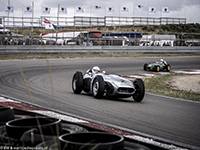 |
Why?
After last year’s huge success – unexpected by many, a wonderful surprise for all – the reborn Historic Grand Prix at Zandvoort was aiming to build on the solid foundation laid down in its debut year hosting to the major international series in historic motor racing. In 2012, a whopping 38,000 visitors took to the track in the Dutch dunes, outscoring the DTM box office result of the week before. Would the meeting be able to top that in its second year running?
Many of the elements of the successful first edition were back for a second time. Masters Historic Racing came out in full force with the two FIA championships for 3-litre F1 cars and big-banger sportscars, again adding the Gentleman Drivers GT endurance category and the Pre-66 Touring Car class to those. The Historic Grand Prix Car Association was back as well, as were Historic Formula 2 and the Dutch National Championship for GTs and Touring Cars. While the turnout for the Pre-66 tourers was disappointing with a total of 14 cars, the FIA Historic F1 grid was boosted by some 15 additional cars from the paltry 8-car grid that turned the two headline races into something of a farce last year. (Although the battles between Manfredo Rossi and Christophe d’Ansembourg were rather excellent.) With noise restrictions now also lifted for the entire Friday, last year’s programme (already fully stuffed) was further expanded with Formula Juniors, Dutch historic single-seaters and the German Youngtimer Challenge. The Coloni C3 Formula 1 demo by Jan Lammers was extended to include another Coloni driven by Michael Bleekemolen, while Arie Luyendijk would be showing a bellowing Can-Am McLaren during the lunch breaks. Finally, fans of two-wheeled racing would be treated to the final demonstration run by the Yamaha Classic Racing Team, headlined by none other than Giacomo Agostini and Steve Baker.
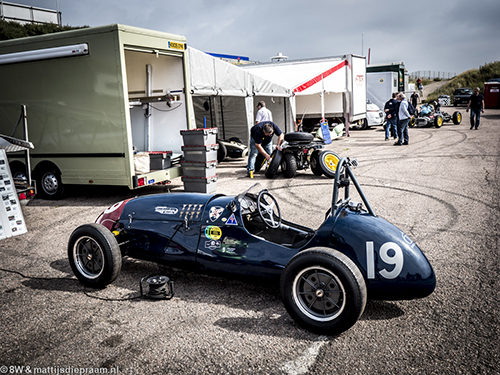
Paul Grant's Cooper was among the lovely assortment of cars in the HGPCA paddock, up behind the Hunzerug.
(photo 8W)
More pictures of the paddock atmosphere at Zandvoort
Another element to make a welcome return was the fine weather. For three days glorious late-summer sun showered the event in wonderful light in 2012, and while the sun this time only made its big break on Friday afternoon and the entire Saturday, the lack of rain moved the fans to the seaside resort in their thousands. The counting stopped at 45,901 this time.
It was a great atmosphere for the many visiting drivers, many of whom were racing at Zandvoort either for the first or the second time in their often long careers. Not so for Jason Minshaw, the experienced historic and modern racer who would be there again the following week for the Trophy of the Dunes event in which the British GT Championship would be guesting. He had now found out the identity of the real treasure of the dunes. “I suspect I will be driving for a slightly more modest crowd next week”, he said after having twice annihilated the HGPCA pre-66 field in his superfast Brabham BT4. “It’s great to see all those people waving and cheering. I mean, there were people in the grandstands during testing here last week! They must really love their historic racing here.” The sentiment was echoed by Tom Coronel, who like last year made a temporary switch to historics and found that “more people seem to be turning out for historic racing rather than modern racing. Maybe I should consider making a full-time switch!”
Coronel spoke during the parade that visited the town centre on Saturday night. The streets of Zandvoort were packed with a huge crowd of locals and fans who had stayed on instead of traveling home. “We considered it an appropriate gift to the village”, said Cooper Mk2 racer Martin Eyre, who with his wife forms a two-man team traveling across Europe for the big historic events, packing the car and all their stuff in a Peugeot Boxer in the way they did in the fifties and sixties (apart from using a Peugeot Boxer, of course). “Bringing our cars to the people adds to the wonderful atmosphere at the track. It’s a great event.”
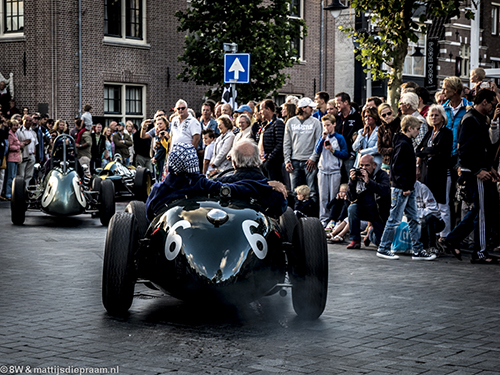
Martin Eyre and his wife were the loveliest couple of the meeting, never more so during the Saturday evening parade through town. (photo 8W)
More pictures of the parade through Zandvoort
Its packed grandstands gave another dimension to Zandvoort’s reputation, which is quickly gathering pace on the international historic calendar. “There are lots of people at the Silverstone Classic”, one competitor said, “but you won’t see them on the grandstands. They are all scattered out across that massive infield, which looks extremely busy with those parking lots crammed with car clubs and their dozens of Ferraris, Jags and Aston Martins. But when you’re racing it’s lonely out there! Here, I actually feel that I am racing in front of a massive crowd.”
Zandvoort itself, having been left behind in the race to modernity instigated by Bernie Ecclestone, was a major contribution to atmosphere as well, with its less-than-perfect facilities. Marcus Pye, active during the weekend for the HGPCA, remembered being present in 1983, with the British Formula Fords that ran as a support act to the F1 cars. “That was thirty years ago, but the place feels the same. And it’s still a proper track. Half of the old track – and the best half – has remained. It’s good for us since the organisers are really helpful and it does help that everyone speaks English. Try that at the Nürburgring! But the drivers love it as well. It’s not just that it’s different – ‘Oh no, not Silverstone again,’ or even ‘not Spa again’ or ‘the Nürburgring, again’ – but it’s a challenge in its own right.”
A rollercoaster, said Minshaw. The most technical circuit in the world, said E-type driver Mark Pangborn, undoubtedly referring to the new section between Scheivlak and the final corner. While most drivers named classic bits of the track as their favourite part – Tarzan for John Delane and Keith Ahlers, Hugenholtz for Rossi, Scheivlak for Minshaw and d’Ansembourg – Sid Hoole made for a refreshing change by arguing that the new section was actually the best bit. “I used to come here all the time but I never raced on the new circuit before. I think it’s actually better than it was. The new section is really interesting and very challenging. I can’t wait to do some proper racing on it.”
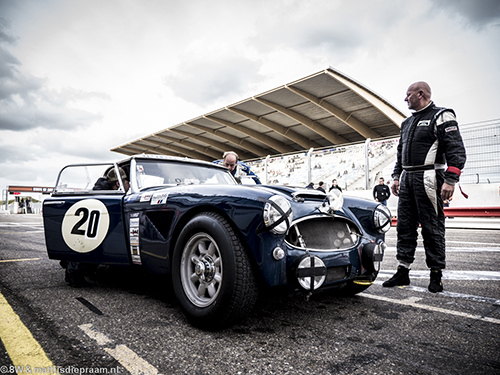
Armand Adriaans watching over his team's other car, as the Healey 3000 changes driver
between Nykle Meijer and Bas Jansen. (photo 8W)
More pit and grid scenes at Zandvoort
For the chauvinistic home crowd the racing was made less interesting when home favourites David Hart and Tom Coronel fell foul to car trouble during the Gentleman Drivers and World Sportscar races. Hart had a viable explanation for his AC Cobra breaking a driveshaft early on in the Gentleman Drivers enduro on Sunday morning. “I think our demo at Rotterdam City Racing proved to be a touch over-enthusiastic…” In practice, the same fate had befallen the sister car of Hans Hugenholtz, son of the former track director, and Alexander van der Lof, son of Dries van der Lof who made his single Grand Prix appearance at Zandvoort in 1952. Charging all the way from the back, the pair managed to salvage fourth in a race won by Rob Hall, ahead of Leo Voyazides and Simon Hadfield, all in Cobras. Adding to that second place, Voyazides/Hadfield were victorious in the FIA Historic World Sportscar race after Hart’s similar Lola-Chevy Mk3B retired from the lead, and for good measure also took the Pre-66 Touring Car races in their Ford Falcon.
The Dutch national anthem was finally heard after the very last race of the weekend when Arie Luyendijk won the national GT and touring-car race in a Bizzarrini 5300 GT on loan from Van der Lof. The American Dutchman hadn’t driven at Zandvoort since 1983. Back then, already racing Supervees in the States, he came over to guest in a one-make Toyota Celica race, still on the old circuit, but the two-time Indy 500 winner still had to acquaint himself with the new section, closed off by the Bos Uit replacement that since 1997 carries his name. “Of course I was here when the corner was christened with my name, but I only did a demo in my Indycar. This is the first time I’m racing the new track! I love my corner, I’m proud they gave it my name. It’s fast, it’s challenging, the only thing is that it’s a right turn instead of a left turn! This morning it almost bit me – twice! – and I thought, let’s be careful here. If there’s one corner I shouldn’t be going off it’s my own. I won’t give you the pleasure of a ‘Luyendijk crashes in his own corner’ headline!”
Apart from the inevitable Voyazides/Hadfield duo the event boasted several other double winners, all celebrating to the tune of ‘God Save the Queen’. Michael Lyons added two more wins to his unbeatable run in FIA Masters Historic F1, this time taking out his father’s former ride, the luridly Penthouse/Rizla-liveried Hesketh 308E, instead of the RAM Williams FW07 in which he had won at Silverstone and the Nürburgring. It made no difference as Simon Fish in the ex-Lammers Ensign was left well behind twice. “The kid’s just too fast”, said Christophe d’Ansembourg who had come out with James Hunt’s McLaren M26. Minshaw was an easy double winner in HGPCA pre-66, while Philip Walker won twice in the pre-61 category. On Saturday, Walker had to work hard to fend off Julian Bronson’s attentions in the Scarab-Offy but when Bronson failed to complete a lap in the second race, Walker had a Sunday drive to a second victory. Peter Morton won twice in the Formula Junior category, as his main rival and poleman James Murray was forced to retire from both races. In Historic Monoposto Racing, Martyn Donn ran away with both races in a Lola T760, the Atlantic car proving much too quick for the rest of the field. Finally, Germany added some flag-and-anthem variety. The Schrey family completely dominated the Youngtimer Challenge races with their pair of Kremer Porsche 935K3s, finishing one-two twice on the trot.
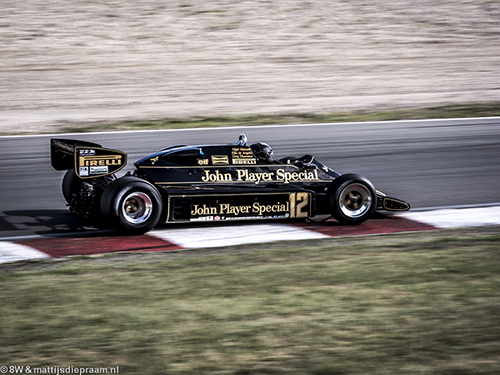
Greg Thornton at full tilt in his Lotus 92 through Kumho corner during the first of the two FIA Masters Historic F1 races. (photo 8W)
More pictures of the track action at Zandvoort
Of course, there was heartache as well. It was said to see the state the Deep Sanderson Formula Junior was in after its driveshaft broke while its driver Christopher Wilks was in full flight through the Arie Luyendijkbocht. The shiny machine that once emanated from the mind of Chris Lawrence was damaged on all corners after Wilks first found the crash barriers head-on. “Early bath, I’m afraid”, Wilks said stoically. “That’s it for the weekend for me.” Fortunately, many rivals sympathized and already offered help in patching up the car. Adrian van Hooydonk had a similarly scary moment in the very same balls-out corner. “I had already felt that something was wrong and came off the throttle. The next moment I saw a wheel running away from me…” The BMW design guru used all of his skill to keep his priceless three-wheeled Linder BMW M3 on the road. “It’s straight out of the museum, and until now was only used as a ‘taxi’ during DTM events. So perhaps that’s why! It’s a wonderful car, though, and I loved racing it here. Although I passed for my racing license here, it’s been ten years since I last drove at Zandvoort. I knocked off four seconds of my time, which gives me a great deal of personal satisfaction.”
Van Hooydonk’s attitude was the embodiment of historic motor racing. While there is some serious racing going on at the front, the majority of the field is there to enjoy their cars, reaching and surpassing their personal goals and being part of a legacy. “We’re just here keeping shop for some of the most beautiful cars in the history of motor racing”, said Adrian van der Kroft. “Our main responsibility is not to crash them.”
And still there’s nothing to prevent that when something happens for which you are unprepared. Brian Maile rolled his Cooper T41 twice when rear tyre burst on the exit of the Audi-S chicane. He escaped unhurt – a miracle considering that his machine did not carry a rollbar. It turned out that not having six-point belts (yet) had saved him. “I submarined and then my right foot shot off the throttle pedal and got stuck between the body and the chassis tube”, said Maile. “This kept me from sliding back up again.” He did have the skid marks on his helmet to show for. The first thing he did afterwards was measure up for a rollbar. “I will never be that lucky twice!” The car itself looked surprisingly undamaged, with all four wheels still attached and the nosecone almost completely untouched. “That’s sturdy British engineering for you”, Maile said, before laughing out loud.
For 2014, the final year of the three-year Masters deal, the organisers are attempting to lure Group C Racing to Zandvoort, while it would also be nice to see Motor Racing Legends contribute to the fun. A Stirling Moss Trophy race through the dunes would be an exciting prospect. Let’s see what they come up with. In terms of audience and sponsorship, the late-August Zandvoort date looks like it’s here to stay.
